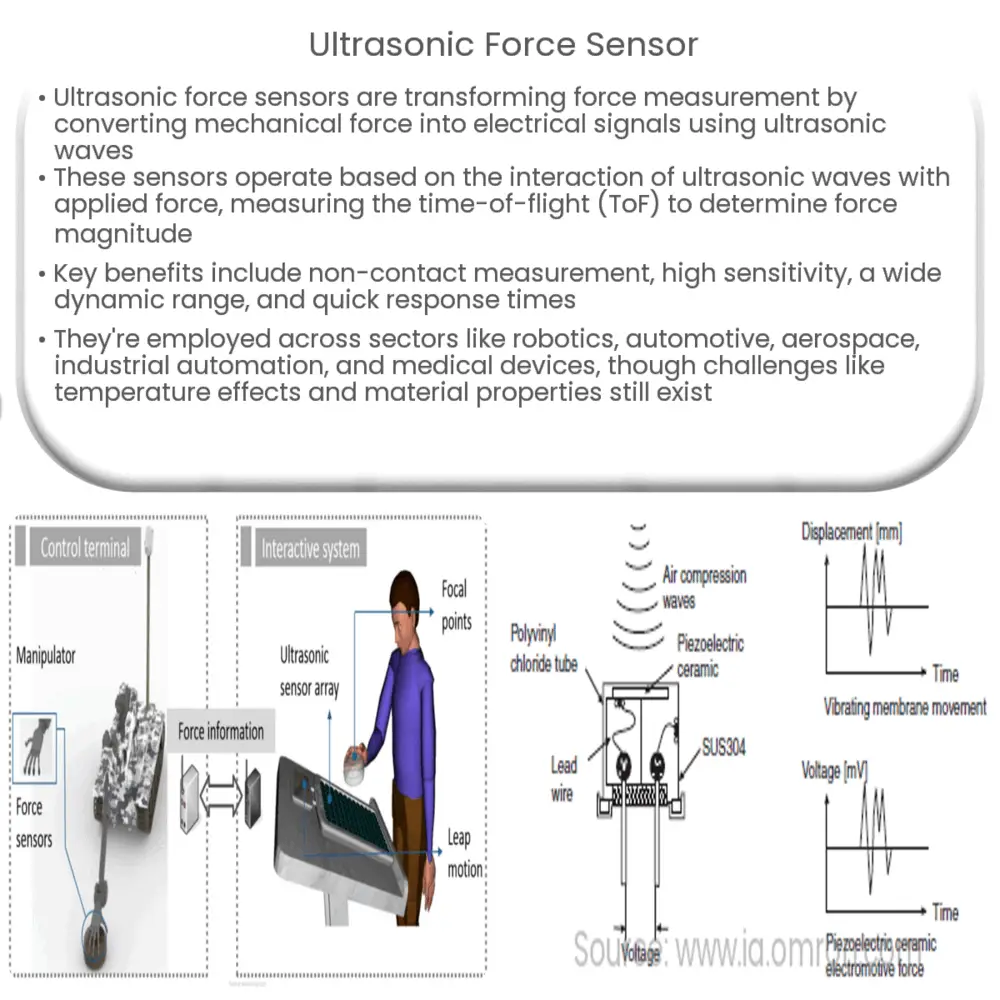Ultrasonic force sensors measure mechanical force using ultrasonic waves, offering high sensitivity, accuracy, and non-contact measurement for diverse applications.

Ultrasonic Force Sensor: Revolutionizing Force Measurement
The field of force measurement has seen significant advancements in recent years, with new technologies providing more accurate and reliable results. Among these groundbreaking innovations is the ultrasonic force sensor, which has the potential to revolutionize the way we measure and monitor forces in various applications. In this article, we will delve into the fundamentals of ultrasonic force sensors, their working principles, and the advantages they offer over traditional force measurement techniques.
What is an Ultrasonic Force Sensor?
An ultrasonic force sensor is a type of transducer that measures and converts mechanical force into electrical signals using ultrasonic waves. The sensor consists of a piezoelectric element that generates ultrasonic waves when subjected to an external force. The waves propagate through the medium and are reflected back to the sensor, which then measures the time delay between the transmitted and received waves to determine the applied force. This innovative technology has found applications in various fields, including robotics, automotive, aerospace, and industrial automation, among others.
Working Principle of Ultrasonic Force Sensors
The fundamental principle behind ultrasonic force sensors is the interaction of ultrasonic waves with an applied force. When force is applied to the sensor, it causes a change in the medium’s mechanical properties, such as its density and elastic modulus. This change in properties alters the velocity of the ultrasonic waves as they propagate through the medium.
The sensor emits ultrasonic waves at a known frequency and measures the time it takes for the waves to travel through the medium and return to the sensor after reflection. The time delay between the transmitted and received waves, known as the time-of-flight (ToF), is directly proportional to the applied force. By analyzing the ToF, the sensor can accurately determine the magnitude of the force applied.
Advantages of Ultrasonic Force Sensors
Ultrasonic force sensors offer several key advantages over traditional force measurement techniques, making them an attractive choice for various applications. Some of these advantages include:
- Non-contact measurement: Unlike traditional force sensors, ultrasonic force sensors do not require direct contact with the object or medium being measured. This non-contact approach allows for accurate force measurement without the risk of damage or wear to the sensor.
- High sensitivity and accuracy: Ultrasonic force sensors can detect minute changes in force with a high degree of sensitivity and accuracy. This enables precise force measurement in applications where small variations in force can have significant consequences, such as in robotic grippers or medical devices.
- Wide dynamic range: Ultrasonic force sensors can measure forces over a wide range of magnitudes, making them suitable for applications with diverse force requirements. This versatility allows them to be used in a variety of industries and settings.
- Fast response time: Due to their reliance on ultrasonic waves, these sensors can provide real-time measurements with rapid response times. This feature is particularly beneficial in dynamic applications where quick force adjustments are necessary.
Applications of Ultrasonic Force Sensors
Ultrasonic force sensors have been increasingly integrated into a variety of applications, thanks to their numerous advantages. Some of these applications include:
- Robotics: Robotic grippers and manipulators use ultrasonic force sensors to accurately measure the forces exerted on objects during grasping, handling, or assembly tasks. This precise force control ensures delicate handling of fragile components and enhances the robot’s overall performance.
- Automotive: In the automotive industry, ultrasonic force sensors are employed for quality control during manufacturing and assembly processes. They are used to measure and monitor forces applied during pressing, clamping, or tightening operations to ensure proper assembly and adherence to specifications.
- Aerospace: Ultrasonic force sensors play a crucial role in aerospace applications, where accurate force measurements are vital for structural testing, component inspection, and flight control systems. They help ensure the structural integrity of aircraft components and maintain overall flight safety.
- Industrial Automation: In industrial settings, ultrasonic force sensors are used for a wide range of applications, including torque measurement, assembly line automation, and quality control. Their high sensitivity and non-contact nature make them ideal for these demanding environments.
- Medical Devices: Ultrasonic force sensors are employed in various medical devices, such as surgical instruments and prosthetic devices, to ensure accurate force application and feedback during critical procedures. This enhances patient safety and improves treatment outcomes.
Challenges and Future Developments
Despite their numerous benefits, ultrasonic force sensors still face certain challenges that must be addressed to further expand their applications and improve their performance. Some of these challenges include:
- Temperature effects: Ultrasonic wave propagation is influenced by temperature, which may impact the accuracy and reliability of force measurements. Developing temperature compensation methods and more robust sensor designs will help mitigate these effects.
- Material properties: The accuracy of ultrasonic force sensors can be affected by the material properties of the medium through which the waves propagate. Developing advanced signal processing techniques and machine learning algorithms to account for these variations will improve the sensor’s performance in different environments and materials.
- Integration and miniaturization: As industries continue to demand smaller and more integrated devices, the development of compact and versatile ultrasonic force sensors will be crucial. Advances in materials science and manufacturing techniques will help enable the creation of smaller, more efficient sensors suitable for a wider range of applications.
In conclusion, ultrasonic force sensors have the potential to revolutionize force measurement by offering a range of benefits over traditional techniques. With continued research and development, we can expect to see even greater advancements in this technology, opening up new possibilities for force measurement across various industries and applications.

